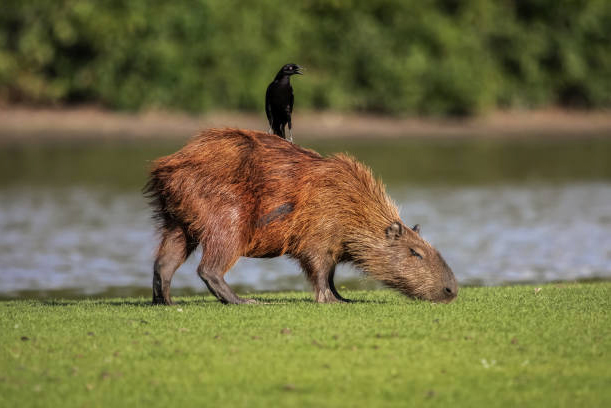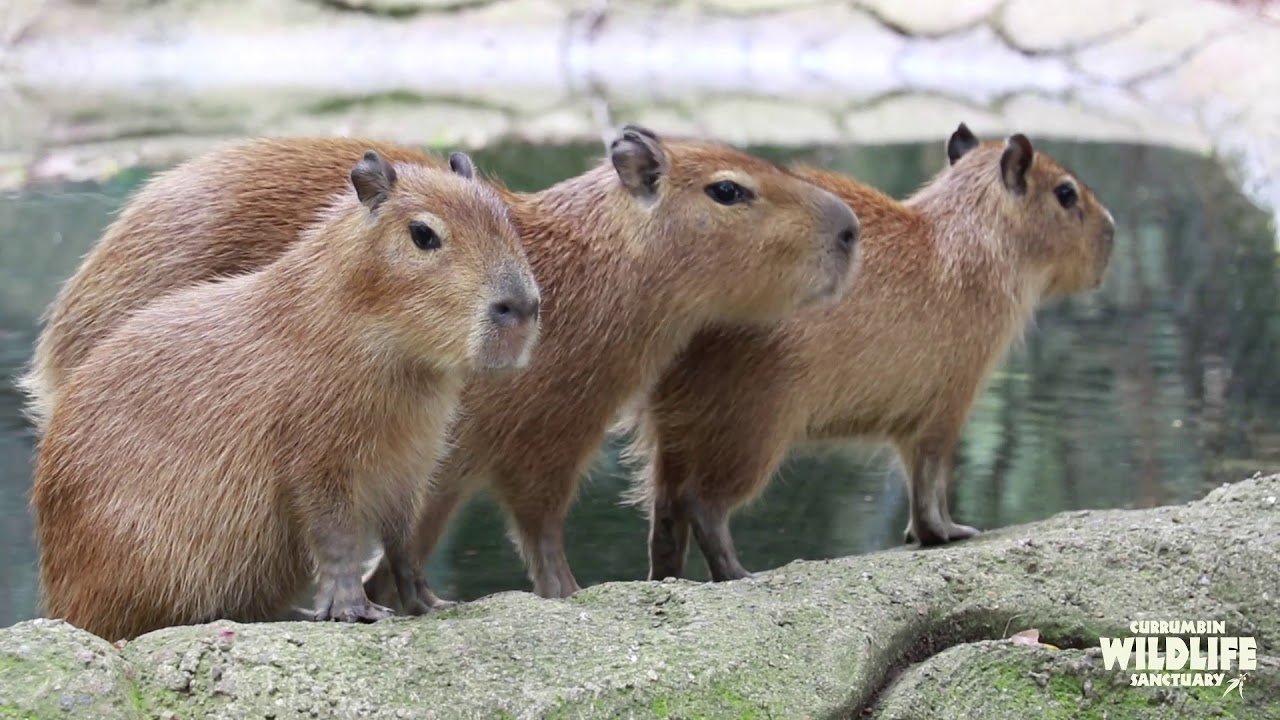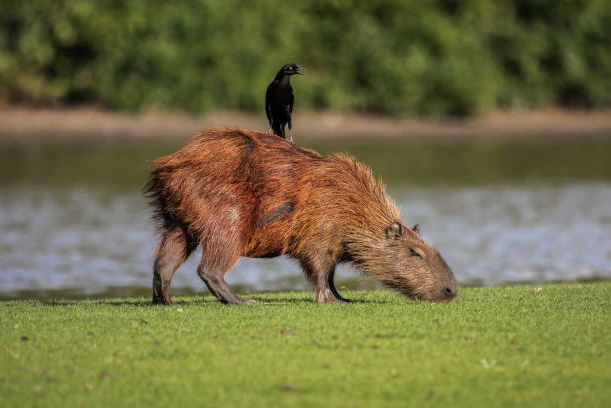Imagine being in the presence of a creature that effortlessly glides through its surroundings, with a grace and speed that defies its seemingly docile nature. Enter the world of capybaras, where these unique and enigmatic creatures possess a surprising talent for swift movement, challenging conventional perceptions. From the lush rainforests of South America to their captivating interactions with other animals, the speed of capybaras is a phenomenon that leaves both scientists and nature enthusiasts alike in awe. Today, we unravel the mysteries surrounding these remarkable creatures as we explore just how fast capybaras can run.
Physiology of Capybaras

1.1 Size and Weight
Capybaras are the largest rodents in the world and can grow to impressive sizes. On average, they measure around 1 to 1.3 meters in length and can weigh between 35 to 65 kilograms. Some exceptionally large capybaras have been recorded to reach weights of up to 80 kilograms. Their large size and weight contribute to their unique physiology and adaptations for survival.
1.2 Limb Structure
One of the key aspects of capybara physiology is their limb structure. They have relatively long and slender limbs, which help them in various aspects of their locomotion. The elongated limbs enable them to cover longer distances with each stride, aiding in their speed and agility.
1.3 Muscle Composition
Capybaras possess a well-developed musculature, particularly in their hind limbs. The muscles in their legs provide the necessary power and strength required for their swift movements. These muscles allow them to generate a significant amount of force, enabling them to accelerate quickly and maintain a steady pace.
Natural Habitat of Capybaras
2.1 Wetlands and Marshes
Capybaras are primarily found in wetlands and marshy areas, as they have a strong affinity for water. These habitats offer them the ideal conditions for thriving, with an abundant supply of vegetation for feeding and water bodies providing a means of escape from predators. The wetlands and marshes also provide essential moisture to keep their semiaquatic bodies hydrated.

2.2 Grasslands and Savannas
In addition to wetlands, capybaras can also be found in grasslands and savannas, where they graze on a variety of grasses and vegetation. These open areas allow them to utilize their large size and speed to their advantage, as they can easily spot potential predators from a distance. The wide expanse of these habitats also provides them with ample space for their locomotion patterns.
2.3 Forested Areas
While capybaras are predominantly associated with wetlands and grasslands, they can also be found in forested areas. Forests provide them with additional sources of food such as fruits, leaves, and bark. They adapt well to the dense vegetation of these habitats, utilizing their agility to navigate through the undergrowth and escape from predators.
Adaptations for Speed
3.1 Long Legs
Capybaras have evolved long and slender legs to facilitate their swift movements. The elongated limbs allow them to take larger strides, covering more ground with each step. This adaptation provides them with an advantage when it comes to speed, enabling them to outrun potential predators or quickly escape from dangerous situations.
3.2 Webbed Feet
Another adaptation that contributes to the capybara’s speed is their webbed feet. These webbed structures between their toes assist in both terrestrial and aquatic locomotion. On land, the webs act as a natural paddle, pushing against the ground and propelling them forward. In water, the webbing increases their surface area, enhancing their ability to swim swiftly and efficiently.

3.3 Efficient Locomotion
Capybaras have developed an efficient style of locomotion that enables them to move quickly while minimizing energy expenditure. Their movements are coordinated and fluid, utilizing their long legs and powerful muscles to propel themselves forward. By employing an energy-saving gait, capybaras are able to maintain their speed over long distances, making them formidable creatures in their natural habitats.
Capybara Locomotion Patterns
4.1 Walking
When capybaras are moving at a leisurely pace, they adopt a walking gait. Walking allows them to conserve energy while covering short distances. Their elongated legs ensure smooth and efficient movement, making walking a preferred locomotion pattern for routine activities such as foraging or exploring their surroundings.
4.2 Trotting
As capybaras increase their speed, they transition into a trotting gait. Trotting involves a diagonal movement of the limbs, with two legs moving together while the other two legs move reciprocally. This gait allows them to cover more ground quickly and efficiently. Their muscular hind legs provide the necessary power and propel them forward with each stride.
4.3 Galloping
When capybaras need to reach their maximum speed, they employ a galloping gait. Galloping is characterized by a bounding motion, where all four legs leave the ground simultaneously. This gait allows capybaras to achieve their top speed and is typically employed when they are evading predators or fleeing from potential threats.
Average Speed of Capybaras

5.1 Terrestrial Speed
Capybaras are impressive runners, capable of reaching respectable speeds on land. On average, they can maintain a speed of around 35 kilometers per hour (22 miles per hour) during short bursts. Their elongated limbs, powerful muscles, and efficient locomotion patterns allow them to cover significant distances in a relatively short amount of time.
5.2 Aquatic Speed
While capybaras are well adapted for terrestrial locomotion, they are equally skilled swimmers. In water, they can achieve speeds of approximately 10 to 15 kilometers per hour (6 to 9 miles per hour). Their webbed feet and streamlined bodies enable them to navigate through water with ease, making them agile and efficient swimmers.
5.3 Comparison with Other Animals
When compared to other animals, capybaras demonstrate impressive speed despite their large size. For instance, they can outpace humans in short bursts and are faster than similar-sized mammals such as pigs or tapirs. However, they are slower compared to some of the world’s fastest land animals, like cheetahs or pronghorns, which can reach speeds of more than 100 kilometers per hour (60 miles per hour).
Factors Affecting Capybara Speed
6.1 Age and Size
The age and size of capybaras can significantly influence their speed. Juveniles, due to their smaller size, are generally faster than adult capybaras. As capybaras grow larger and heavier, their speed may decrease slightly. However, even larger adults can still maintain impressive speeds when necessary, thanks to their efficient locomotion patterns and powerful muscles.

6.2 Environmental Conditions
Environmental conditions can also impact the speed of capybaras. Wet or muddy terrain can hinder their movement, slowing them down to some extent. Similarly, extreme heat or cold can affect their overall performance, leading to reduced speed. However, capybaras are adaptable creatures and can modify their behavior and locomotion patterns to cope with varying environmental conditions.
6.3 Predation Risk
The presence of predators can significantly influence the speed at which capybaras move. When faced with imminent danger, capybaras can achieve remarkable bursts of speed to evade predators. The threat of predation can act as a potent motivator, prompting capybaras to push their physical limits and reach their maximum velocity in order to ensure their survival.
Capybaras as Prey
7.1 Predators
Capybaras face a range of predators in their natural habitats. Some of the main predators include large cats such as jaguars and pumas, as well as large reptiles like caimans and anacondas. Birds of prey such as eagles and crocodiles are known to prey on young or weaker capybaras. The presence of these predators has influenced the capybaras’ evolution of high-speed capabilities as a means of defense.
7.2 Speed as an Escape Mechanism
Speed plays a crucial role in capybaras’ ability to escape from their predators. Their powerful leg muscles and efficient locomotion patterns allow them to outrun many potential threats. Their long legs and webbed feet aid in quick movement across varied terrains, enabling them to swiftly navigate obstacles and increase their chances of eluding their predators.
7.3 Group Defense Strategies
In addition to their speed, capybaras have developed effective group defense strategies to enhance their chances of survival. They often live in large social groups, known as herds, which provide safety in numbers. When under threat, capybaras will alert others in the herd and coordinate their escape efforts. Their communal defense mechanisms, combined with their impressive speed, make them formidable adversaries for predators.
Capybaras in Captivity
8.1 Exercise and Enrichment
Capybaras kept in captivity require regular exercise and enrichment to maintain their physical and mental well-being. As naturally active animals, they need ample space to roam and engage in their instinctual behaviors. Providing opportunities for them to move, swim, and explore not only ensures their fitness but also helps prevent boredom and certain health-related issues caused by inactivity.
8.2 Recreational Activities
Encouraging recreational activities can further stimulate capybaras in captivity. This can include the use of toys, puzzles, or obstacle courses that mimic their natural environment. By engaging in these activities, capybaras can utilize their speed and agility, keeping their bodies and minds active. It also provides mental stimulation and mimics natural foraging behaviors, promoting overall psychological well-being.
8.3 Ethical Considerations
Keeping capybaras in captivity raises important ethical considerations. It is essential to ensure that their needs for space, socialization, and enrichment are met to promote their overall welfare. Additionally, responsible ownership involves providing proper veterinary care, a suitable diet, and an environment that closely resembles their natural habitat. The establishment of standards and regulations plays a crucial role in ensuring the ethical treatment of capybaras in captivity.
Human Interaction with Capybaras
9.1 Hunting
Capybaras have been historically hunted for their meat, fur, and skin. Their meat is considered a delicacy in some cultures, and their hides are used to create leather products. However, responsible hunting practices and regulations are necessary to maintain sustainable populations and protect these unique animals. Conservation efforts and education on the ecological role of capybaras can help strike a balance between human needs and wildlife preservation.
9.2 Ecotourism
Capybaras are increasingly becoming a popular attraction for ecotourism activities. Visitors are drawn to observe these fascinating creatures in their natural habitat and learn about their ecology and behavior. Care must be taken to ensure that ecotourism activities are conducted responsibly, minimizing disturbance to capybara populations and their habitats. This can be achieved through designated viewing areas, trained guides, and strict adherence to ethical guidelines.
9.3 Conservation Efforts
Conservation programs play a vital role in protecting capybaras and their habitats. These initiatives focus on preserving wetlands, grasslands, and forested areas where capybaras thrive. By safeguarding their natural habitats, implementing sustainable hunting regulations, and promoting education and awareness, conservation efforts aim to ensure the long-term survival of capybaras and their crucial role within the ecosystems they inhabit.
Conclusion
The speed of capybaras is a remarkable aspect of their physiology and behavior. Their large size, long legs, and powerful muscles enable them to move swiftly and efficiently both on land and in water. These adaptations, coupled with their well-coordinated locomotion patterns, make them formidable runners and swimmers. Capybaras’ high-speed capabilities serve as an essential defense mechanism against predators, while also facilitating their search for food and interaction with their environment. Understanding and appreciating the speed of these fascinating creatures is critical in fostering their conservation and coexistence with humans in a responsible and sustainable manner.



